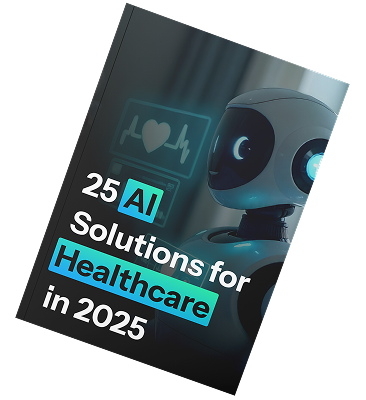6 Tips for Online Pharmacy App Development in 2025

The pharmacy revolution isn’t coming. It’s already here, and your corner drugstore is about to become a museum exhibit.
While most consumers comfortably buy everything online, they still drive to physical pharmacies for medications. This disconnect creates healthcare’s biggest wealth transfer opportunity, as digital platforms quietly capture high-margin specialty prescriptions and transform how medications reach patients.
Whether you’re a pharmacy owner watching customers vanish or a tech entrepreneur seeking the next unicorn, discover:
- Online pharmacy hits $354B by 2032 (13.6% CAGR) yet 65% of Americans haven’t tried it and it’s a pure opportunity.
- Saudi Arabia leads at 90% adoption while the U.S. lags despite a $500B market.
- The best examples of mobile pharmacy apps: GoodRx (10M+ downloads), My Therapy (5M+ downloads), Healthera (750K users).
- Game-changing trends: AI unlocks $100B value, cosmetics surge to $95.75B, smart apps slash costs 50% while 10x-ing prescription volume.
Online Pharmacy Apps Market Overview
Online pharmacy is healthcare’s next frontier. It is projected to reach $354 billion by 2032 and we’re witnessing a 13.6% annual growth story that’s reshaping how medications reach patients worldwide.
Yet here’s the opportunity most are missing, while 87% of UK consumers happily shop online for everything else, only 35% of Americans have ever purchased from an online pharmacy.
Also, despite online platforms capturing 37% of high-margin specialty prescriptions, only 13% of consumers call them their primary pharmacy. Local trust still matters, creating a unique opportunity to blend digital convenience with neighborhood credibility.
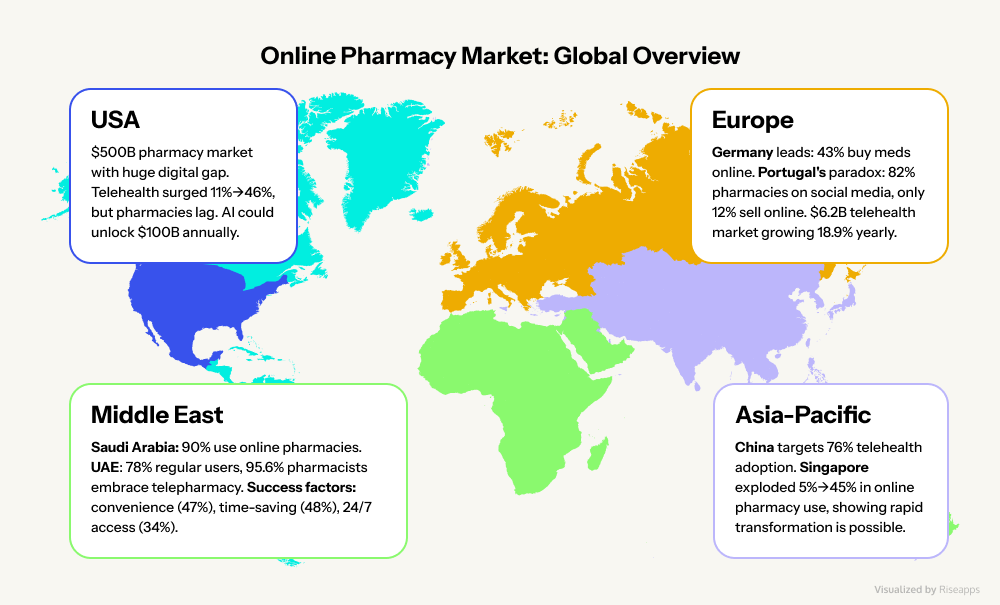
- The USA: Despite the U.S. pharmacy market’s impressive $500 billion valuation, digital transformation lags significantly behind other healthcare sectors: a stark contrast to telehealth’s explosive growth from 11% to 46% adoption. This digital gap presents an enormous opportunity, with McKinsey projecting that AI integration alone could unlock $100 billion in annual value across U.S. healthcare.
- Asia-Pacific: Asia is revolutionizing pharmacy overnight. China targets 76% telehealth adoption, while Singapore catapulted from 5% to 45% online pharmacy adoption in record time.
- Europe: Europe perfectly illustrates your opportunity. Germans lead with 43% of customers buying medications online, while Portugal’s pharmacies showcase the disconnect: 82% maintain social media, yet only 12% enable online purchases. The $6.2 billion telehealth market grows at 18.9% annually, but “rogue” pharmacy fears (47% in the UK) create trust barriers savvy developers can exploit.
- Middle East: Want to see the future? Look at Saudi Arabia’s 90% online pharmacy usage or UAE’s 78% regular users. Their formula is simple: prioritize convenience (47%), time savings (48%), and round-the-clock access (34%). When 95.6% of UAE pharmacists embrace telepharmacy, resistance becomes futile.
Emerging worldwide trends: The cosmeceuticals sector represents pharmacy’s most promising frontier, racing toward $95.75 billion by 2030 with a robust 7.45% annual growth rate. This beauty-pharmacy convergence has captured pharmacists’ attention, earning a 4.38/5 importance rating, by transforming traditional business models.
What are the Benefits of Online Pharmacy App Development?
Online pharmacy apps transform traditional healthcare delivery by eliminating geographical barriers, boosting medication adherence, and slashing operational costs by up to 50%.
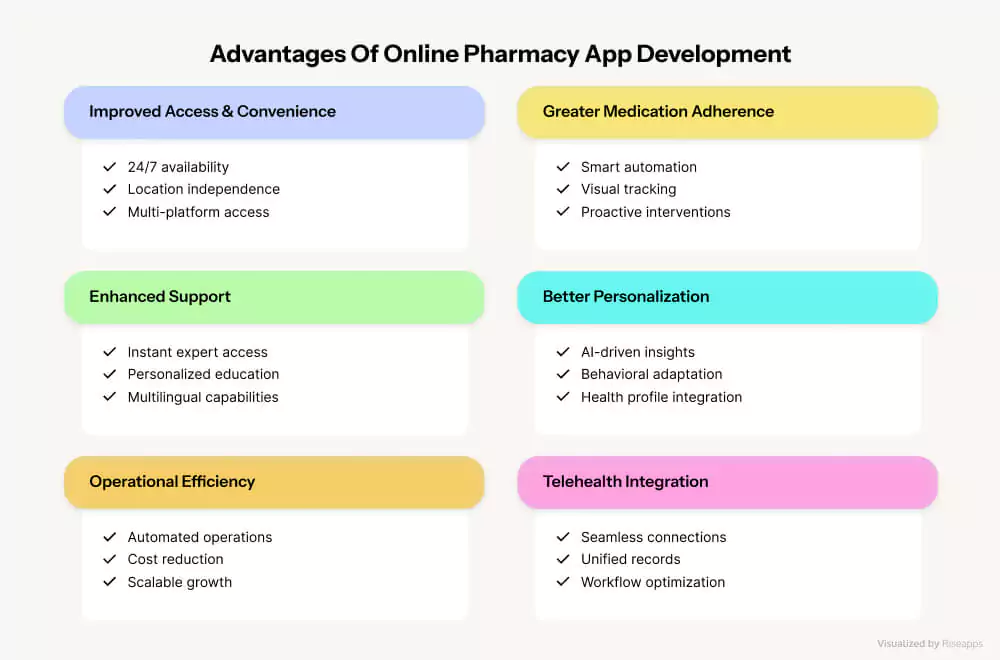
From 24/7 AI-powered support to seamless telehealth integration, these digital solutions create win-win scenarios for patients seeking convenience and pharmacies pursuing growth.
Improved Access & Convenience
With online pharmacy apps, patients can request and manage prescriptions, track orders, and get medication information anytime, anywhere. About 27% of adults aged 50+ in the U.S. report using online drug discount or pharmacy platforms primarily for convenience. Moreover, 79 % of existing online-pharmacy users say they are “very likely” to reuse those services.
Greater Medication Adherence
Online pharmacy apps revolutionize medication adherence by creating an intelligent safety net: automated refills arrive before bottles empty, smart reminders ping at perfect moments, and visual dashboards track every dose taken. This leads to an increase in e-prescription use. For example, in 2025, over 55.9 million e-prescriptions were processed, a jump of 35.4 % over 2024.
Enhanced Support
The global healthcare chatbot market is set to reach USD 459.41 million by 2025, growing at a CAGR of 20.9% through 2033. This rapid expansion extends to online pharmacy solutions. By integrating instant expert consultations with personalized drug education, side effect tracking, and multilingual capabilities, these platforms create a comprehensive digital safety net. The result is a continuous care ecosystem that transforms confused patients into empowered health advocates.
Better Personalization for Higher Engagement
Online pharmacy apps leverage AI to deliver uniquely personalized experiences tailored to individual users. These intelligent platforms analyze health profiles and behavior patterns to provide smart reminders that sync with daily routines. The power of this personalization is evident in real-world applications. SwipeRx, a Southeast Asian platform, successfully implemented reinforcement-learning models to customize product recommendations for pharmacists and pharmacies, resulting in increased basket sizes and higher engagement.
Operational Efficiency & Cost Savings
Online pharmacy applications slash operational costs by automating inventory management, eliminating physical storefronts, and streamlining prescription processing. These digital solutions leverage AI-powered demand forecasting, automated refill systems, centralized distribution centers, and paperless operations to reduce overhead by up to 50%, while faster fulfillment and reduced staffing needs enable pharmacies to process 10x more prescriptions daily.
Better Integration with Telehealth Ecosystems
Web pharmacy apps serve as central hubs within the healthcare ecosystem, seamlessly connecting telemedicine platforms, EHR systems, laboratories, and insurance providers. By breaking down traditional silos and creating unified workflows, these integrated solutions deliver the connected care experience that consumers and providers now demand.
6 Tips of Web and Mobile Pharmacy App Development
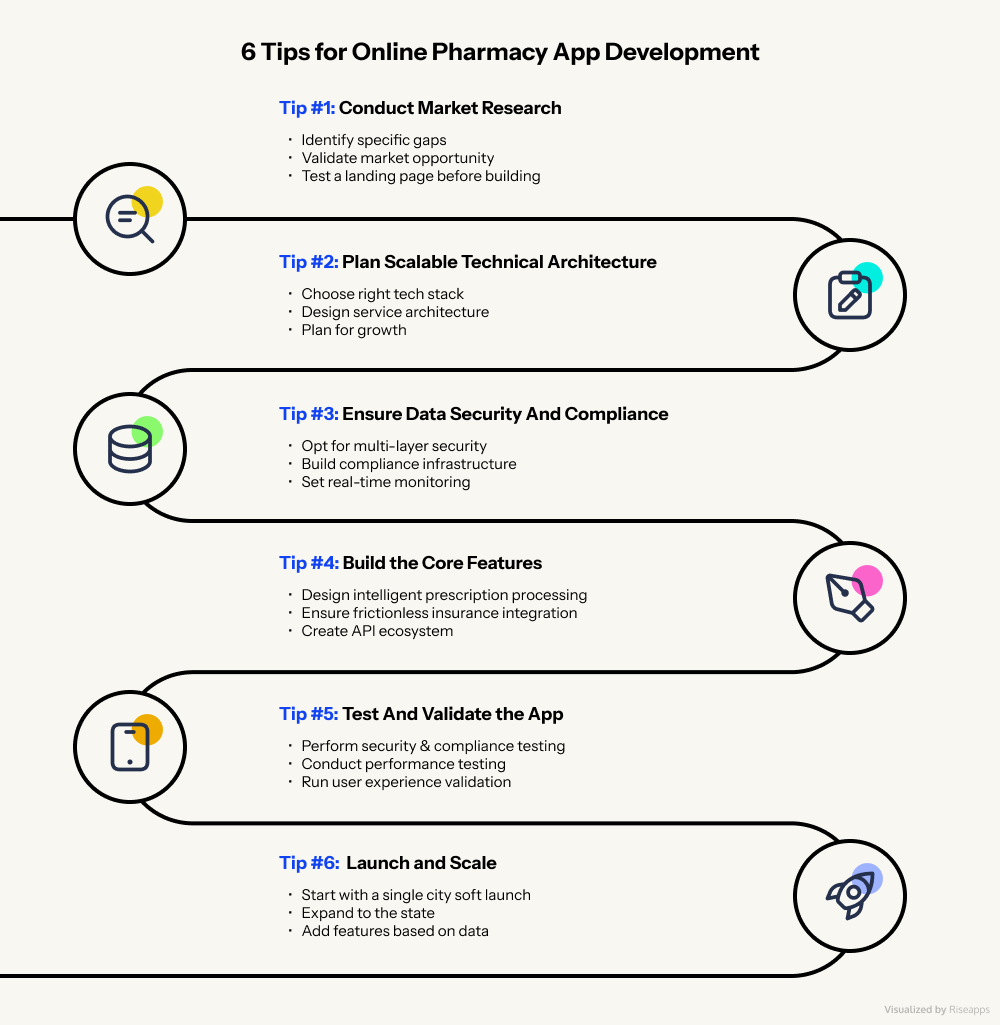
Tip #1: Conduct Market Research
Start by diving deep into specific market gaps rather than broad demographics. Drill into consumer pain points (e.g. prescription delays, limited rural access), estimate addressable market, and benchmark peer apps.
Focus on quantifiable pain points like rural customers waiting 72+ hours for medications or 40% of users who abandon carts due to insurance confusion. Choose a lean but differentiated offering (e.g. on-demand delivery, telepharmacist chat, insurance support) and reject scope creep. Test your concept with focused landing pages targeting specific user segments.
Tip #2: Plan Scalable Technical Architecture
The biggest mistake new pharmacy apps make is building for today’s needs. Because, when you hit 10,000 daily orders, rebuilding your architecture means downtime which can be life-threatening.
Choose platforms (native iOS/Android, cross-platform, web PWA), backend services, and cloud infrastructure that support scalability.
Build separately essential services like prescription service, inventory service, order management, and compliance service. Also, design flows that simplify tasks like uploading prescriptions, browsing drugs, and tracking deliveries, while balancing security (e.g. biometric login) and clarity.
Tip #3: Ensure Data Security and Compliance
With 305 million healthcare records breached in 2024, users need to see and feel that their data is protected.
Layer your defenses strategically with:
- Biometric login with seamless MFA fallback
- Field-level encryption for every piece of health data
- API rate limiting that stops abuse without frustrating legitimate users
- Real-time monitoring with 15-minute response windows
Choose HITRUST-certified infrastructure partners who understand healthcare’s unique requirements. It ensures incident rates drop below 1% in certified environments. Also, map out compliance requirements for each state you plan to operate in. And build the infrastructure with the EU Health Data Space (launched in March 2025) in mind.
Tip #4: Build the Core Features
Typically, the prescription upload process can make or break your app. Users may have crumpled, poorly lit prescription photos. So you need to build features like a smart prescription scanner that guides users to extract text and show it to users for confirmation or flag potential errors.
Keep in mind, insurance verification causes 40% of pharmacy app cart abandonment. Fix this by pre-verifying insurance during account setup or showing exact copays before checkout. In addition, expose clean, versioned APIs so third parties (labs, insurers, pharmacies) can plug in easily, fostering ecosystem extension.
Tip #5: Test and Validate
A compliance failure or security breach can end your business overnight. Test your solution comprehensively across domains:
- Security: perform full penetration testing, not just automated scans
- Performance: simulate 10,000+ concurrent users during peak refill times
- Compliance: conduct Third-party HIPAA audit before launch
- Usability: achieve 85%+ task completion for prescription uploads
Run a controlled pilot with 500 users in a single metro area. Monitor everything: prescription rejection rates (target <5%), cart abandonment (<30%), and support ticket patterns. Use real-world pilot groups, ideally in controlled regions, to collect feedback.
Tip #6: Launch and Scale
Resist the urge to launch nationwide. Start with one city, perfect your operations, then expand methodically.
- Week 1-4: Choose a mid-sized city (100,000-500,000 population) for your initial launch. This gives you enough volume to test systems without overwhelming your team. Monitor order volumes by hour, prescription rejection reasons and rates, and delivery success rates by neighborhood.
- Week 5-8: Once city operations run smoothly, expand statewide. New challenges emerge in interstate prescription transfers, rural delivery logistics, and varying insurance networks. Rural delivery might require partnering with local pharmacies as pickup points.
- Week 9-12: Add features users actually want like an interaction checker, family profiles, or pickup options. Once the launch phase is completed, start continuously monitoring the app’s performance, fix bugs, add new features, and improve the user experience.
6 Types of Pharmacy Applications: Examples and Key Features
From medicine delivery platforms like Healthera transforming smartphones into pocket pharmacies, to AI-powered drug interaction checkers that could save lives, the pharmacy app ecosystem offers specialized solutions for every healthcare need. These six distinct app categories demonstrate how digital innovation is reshaping pharmaceutical care delivery.
1. Online Medicine Delivery Apps
App Examples: Healthera, Netmeds, PharmEasy
Online medicine delivery apps are digital platforms that transform smartphones into pocket pharmacies, offering prescription ordering, virtual consultations, and doorstep delivery.
These solutions make essential medications accessible without leaving home, especially crucial for elderly or mobility-challenged patients.

Key features: secure prescription uploads, medication reminders, real-time order tracking, price comparisons across pharmacies, and 24/7 doctor consultations.
A good example of this app type is Healthera. It is an NHS-recommended telepharmacy platform that has achieved over 100,000 downloads across Apple Store and Google Play app stores, serving a remarkable 750,000 active users with a reach of 20 million UK patients.
When Healthera needed to scale their platform, they partnered with Riseapps to transform their outdated system. In just 6 months, Riseapps delivered a complete renovation that reduced bugs by 30% and enhanced user experience across web and mobile platforms. The team’s expertise in healthcare compliance and NHS integration ensured seamless system connectivity while maintaining regulatory standards.

▶️ Read the full case study on how Riseapps helped Healthera with in-depth UI/UX audit and design of a web & mobile platform.
For businesses entering the telepharmacy market, Riseapps offers proven expertise in creating scalable, compliant healthcare solutions that connect thousands of pharmacies with millions of patients.
2. Pill Trackers
App Examples: Medisafe, CareClinic, MyTherapy
Pill tracking apps serve as intelligent medication guardians, transforming chaotic pill schedules into organized, fail-proof routines through personalized alerts and comprehensive adherence monitoring.
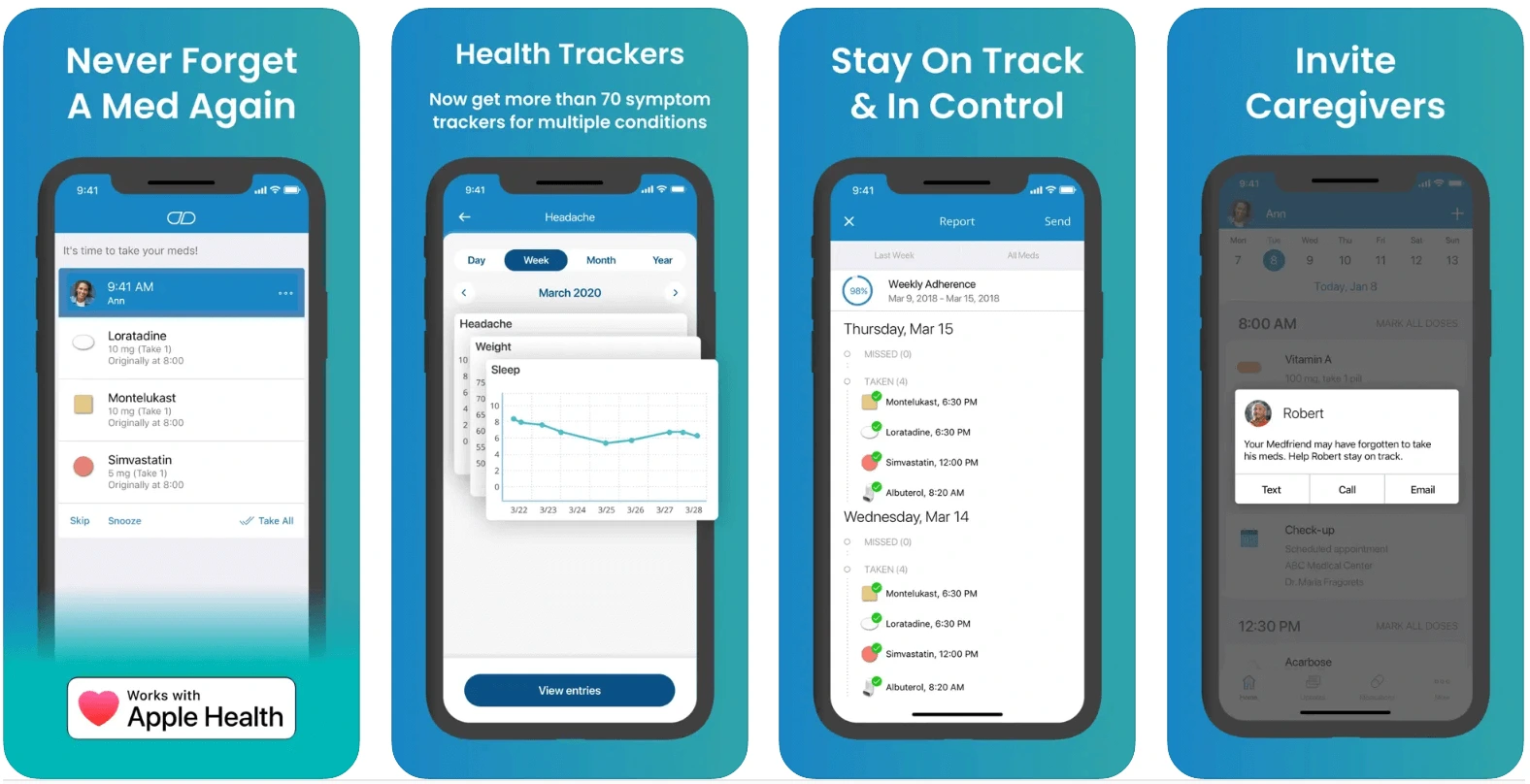
Never miss a dose again. They become a pocket pharmacist that safeguards your health 24/7, particularly vital for patients juggling multiple medications or complex treatment plans.
Key features: visual pill identifiers, customizable reminder tones, drug interaction checkers, refill notifications, shareable adherence reports.
3. Pharmacy Discount Apps
App Examples: GoodRx, SingleCare, Blink Health
Pharmacy discount apps are digital savings tools that slash prescription costs by aggregating coupons, comparing prices across pharmacies, and providing instant access to manufacturer discounts and generic alternatives.
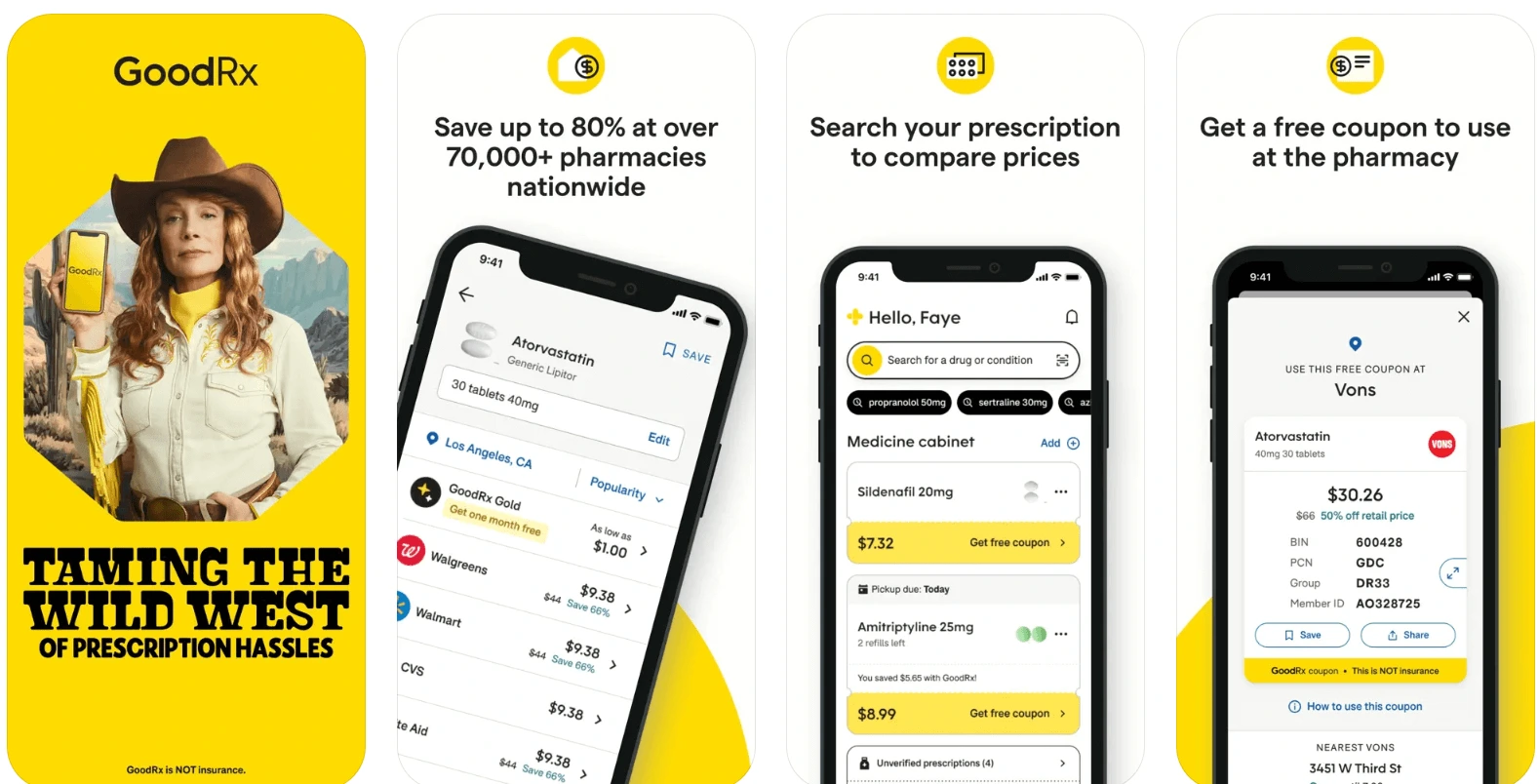
These apps transform expensive medications into affordable healthcare solutions, especially crucial for uninsured patients or those facing high copays.
Key features: real-time price comparisons, digital discount cards accepted at major pharmacy chains, prescription savings calculators, family account sharing, and location-based pharmacy finders.
4. Drug Interaction Checkers
App Examples: Drugs.com, Medscape, Epocrates (Athenahealth), UpToDate Lexidrug (formerly Lexicomp), Micromedex (IBM Watson Health)
Drug interaction checkers are digital safeguards that instantly cross-reference medications to flag potentially fatal combinations, transforming your smartphone into a pharmaceutical safety net. One scan could save your life.
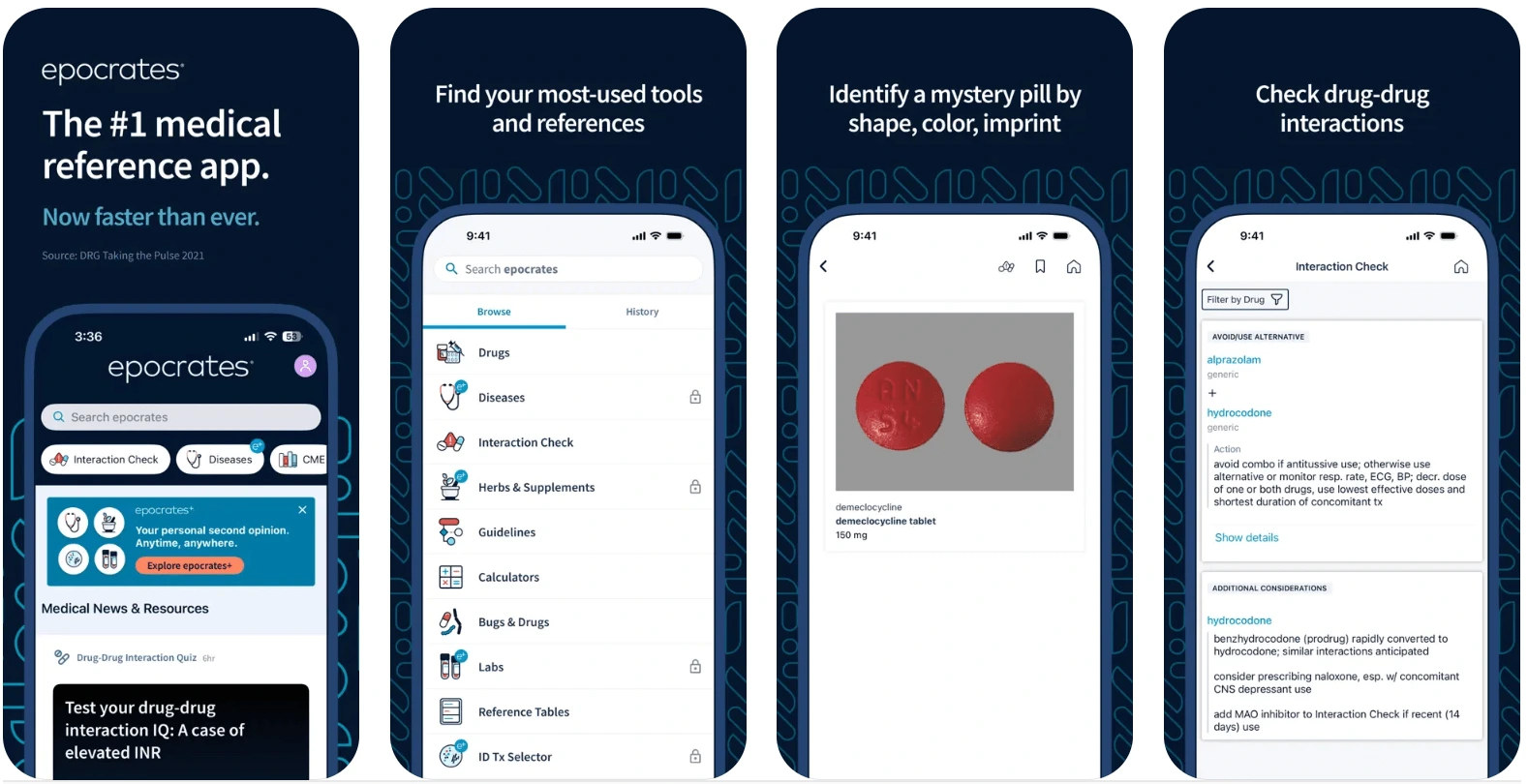
They provide 24/7 pharmaceutical expertise that prevents dangerous cocktails, especially critical for patients juggling prescriptions from multiple doctors or mixing supplements with medications.
Key features: real-time interaction analysis, color-coded severity warnings, comprehensive alerts for food and alcohol conflicts, personalized medication profiles.
5. Dosage Calculator Apps
App Examples: Calculate by QxMD, PediSafe, MDCalc
Dosage calculator apps are clinical precision tools that transform complex pharmaceutical mathematics into instant, error-free calculations, eliminating the deadly guesswork that claims thousands of lives annually.
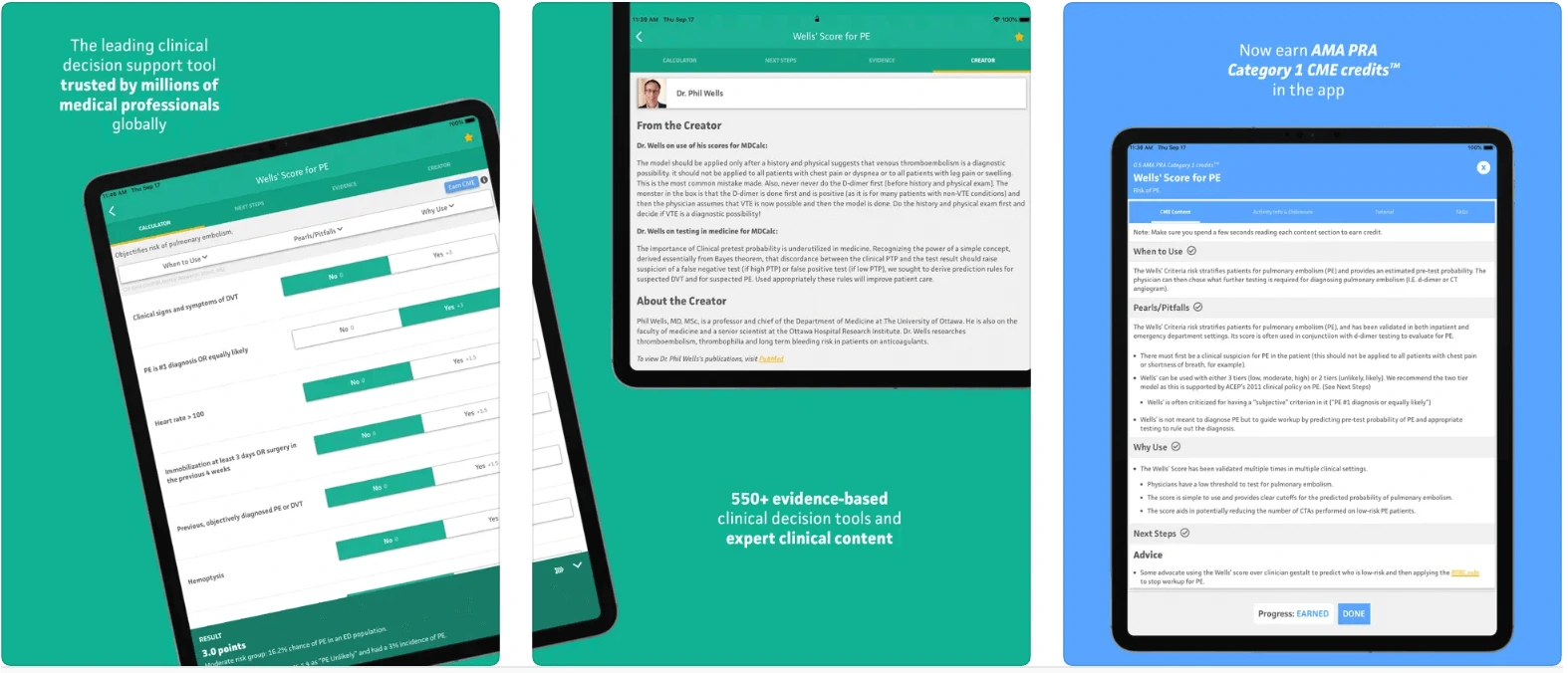
These sophisticated digital pharmacists deliver hospital-grade accuracy in your pocket, absolutely critical for healthcare providers managing high-stakes medications like chemotherapy.
Key features: weight-based pediatric algorithms, real-time renal and hepatic adjustment formulas, IV infusion rate calculators, automatic unit conversions, and red-flag warnings for toxic doses.
6. Telehealth and Virtual Clinical Pharmacist Apps
App Examples: NowRx, Phlo Digital Pharmacy, Alto Pharmacy
Telehealth and virtual clinical pharmacist apps revolutionize pharmaceutical care by placing board-certified pharmacists in your pocket, delivering expert medication consultations through secure video calls that rival face-to-face encounters.
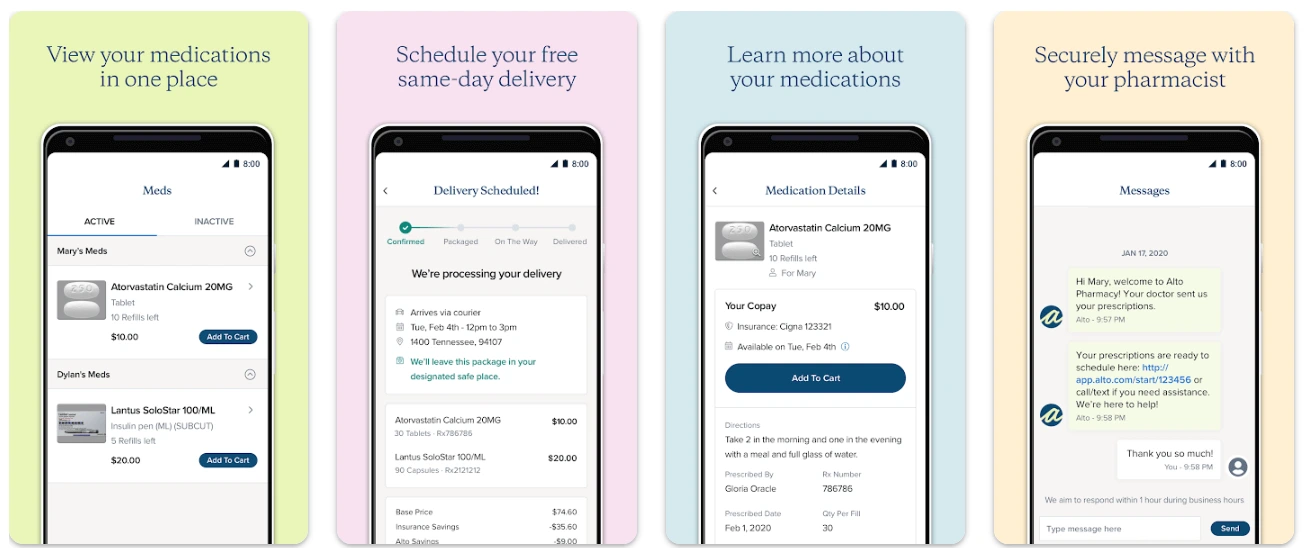
They provide access to pharmaceutical expertise that once required appointments weeks away, proving invaluable for rural communities isolated from specialty care.
Key features: comprehensive medication therapy reviews, real-time prescription problem-solving, personalized vaccine consultations, chronic disease management coaching, drug interaction assessments, and direct coordination with your healthcare team.
8 Critical Features of an Online Pharmacy Applications
1. Prescription Management System
One of the top features a pharmacy app should have is a digital prescription hub featuring smart scanning technology, automated refill scheduling, and seamless physician integration. The Walgreens mobile app exemplifies this perfectly. With this application, customers can scan their prescription bottle to instantly request refills, use auto-refill feature and smart reminders, and track prescriptions across family members from one dashboard.
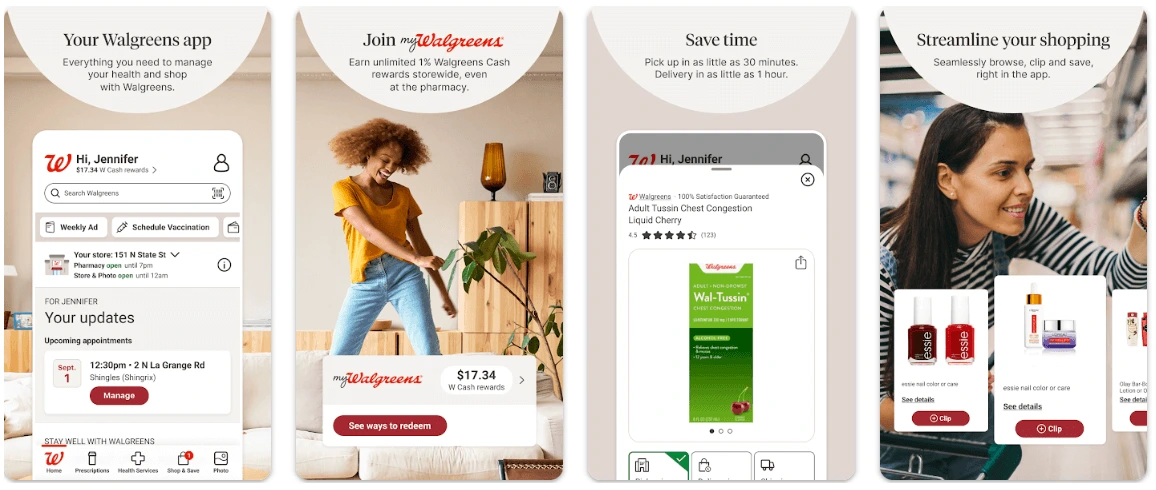
2. Multi-Layered Security Infrastructure
Another important feature is a multi-layered app protection combining biometric authentication, end-to-end encryption, and blockchain technology for tamper-proof records. This fortress-like system safeguards sensitive health data while maintaining user-friendly access through streamlined login processes.
3. Real-Time Order Intelligence
The pharmacy app should be completely transparent from cart to doorstep with live tracking, predictive delivery windows, and instant status updates. Integration with multiple logistics partners ensures reliable delivery while keeping users informed at every step. Rx2Go demonstrates this in action. Processing 475,000+ monthly deliveries across eight states, they offer advanced real-time order tracking for pharmacies, drivers, and patients.
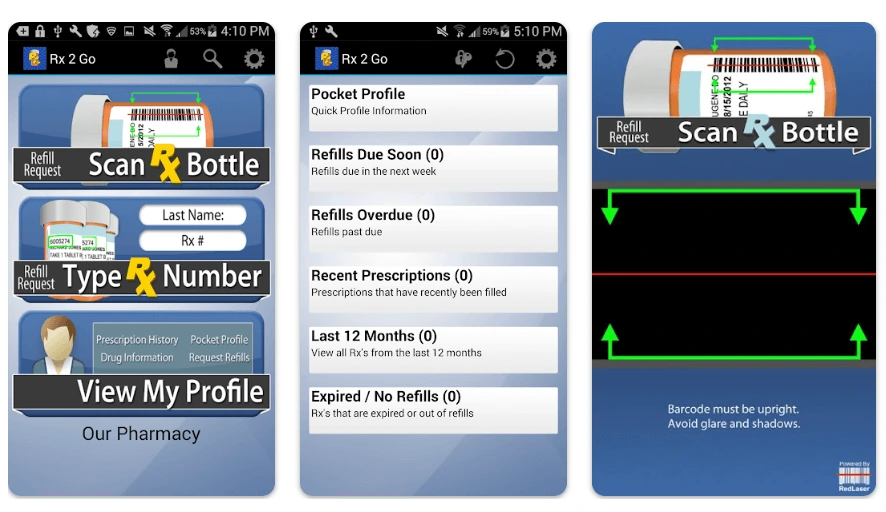
4. Unified Payment Ecosystem
One more necessary feature on the list is secure transaction processing supporting diverse payment methods from digital wallets to insurance integration. The app should handle copayments, split billing, and maintain PCI compliance while offering one-click reordering for convenience.
5. AI-Powered Health Assistant
It’s important for the pharmacy app to have intelligent medication reminders that adapt to user routines, coupled with drug interaction checking and personalized health insights. Consider DoseMed’s approach to intelligent medication support. This app uses AI to drive reminders and adjustments rather than simple static alarms and has an AI assistant whose users can ask questions about their medications.
6. Smart Notification & Communication System
Another must-have feature are orchestrated push notifications delivering medication reminders, order updates, and health alerts without overwhelming users. It also implies 24/7 customer support through AI chatbots and human specialists for immediate assistance. Leading pharmacy platforms like Express Scripts, Amazon Pharmacy, and Healthera support in-app push notifications and mobile alerts for order status updates as well as chatbot integration.
7. Extendable Infrastructure
App users want to have direct access to healthcare professionals through video consultations, chat support, and prescription renewals. That’s why the solution infrastructure should integrate appointment scheduling, symptom assessment tools, and seamless prescription transfer from virtual visits to the pharmacy.
In addition, a pharmacy app needs bi-directional integration with EHR/EMR systems, insurance providers, and healthcare networks.
▶️ Learn how we helped with infusion management platform integration with Infusmart and eClinicalWorks and AthenaHealth for oncology centers.
Seamless connectivity with fitness trackers and health monitors are important as well to create comprehensive wellness profiles in pharmaceutical apps. The pharmacy application should correlate medication schedules with biometric data to provide holistic health insights and adherence tracking.
▶️ Check how we helped a promising footwear brand with AI fitness app development and connected to advanced shoe sensors in this case study.
8. Gamification & Rewards Program
A pharmacy app needs to integrate a motivational framework transforming medication adherence into engaging experiences through achievement systems, loyalty points, and tangible rewards.
With this feature, users can earn benefits for consistent medication compliance and healthy behaviors.
Discover how we helped a footwear brand with incorporation of Gamification Elements and rewards in this success story.
How Riseapps Approaches Telemedicine Solutions
The telepharmacy revolution isn’t just about moving the pharmaceutical industry online. It’s about reimagining how services are delivered, accessed, and experienced.
At Riseapps, we don’t just develop web and mobile pharmacy apps. We architect digital transformations that deliver measurable impact through:
- Proven results: From 40x efficiency gains to 300% faster clinical outcomes
- Speed to market: Full platforms delivered in 6-8 months, not years
- Compliance excellence: ISO 27001, ISO 9001, and 100% HIPAA compliance guaranteed
- Healthcare expertise: Supporting 100,000+ doctors and 1M+ patients globally
- End-to-end solutions: From AI integration and EHR connectivity to custom workflows
Also, we can help with comprehensive analysis of existing platforms, creation of complex AI-powered web and mobile telepharmacy platforms, upgrading outdated pharmacy platforms to support high user loads, and implementing multi-component modules.
Want to build an AI-powered app like Healthera?
FAQ
How much does it cost to develop a pharmacy app?
Pharmacy app development costs range from $50,000-$300,000+. Basic prescription management apps start at $50,000, while comprehensive platforms with medical integrations, HIPAA compliance, telehealth features, and multi-platform support can exceed $200,000, depending on complexity and customization requirements.
How to make an app for pharmacy?
To create a pharmacy app: 1. Define features (prescriptions, reminders, refills); 2. Ensure HIPAA/regulatory compliance; 3. Design user-friendly interface; 4. Integrate pharmacy systems/APIs; 5. Develop for iOS/Android; 6. Test thoroughly; 7. Launch with pharmacy partnerships.
How to develop a telehealth program?
Launch in 90 days: secure state licenses (2-4 weeks), implement encrypted platform supporting 500+ concurrent sessions, train staff (95% competency required), establish 5-7 insurance partnerships, create clinical protocols. Successful programs achieve 89% patient retention and 4.8/5 satisfaction scores.
Is an online pharmacy profitable?
Yes, online pharmacies can be highly profitable with margins of 15-30%. Success depends on efficient operations, competitive pricing, strong supplier relationships, regulatory compliance, and effective digital marketing. High volume and recurring prescriptions drive profitability.
Contact Us



